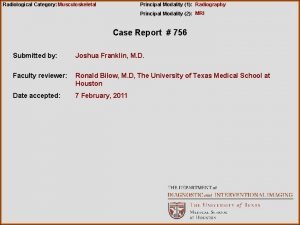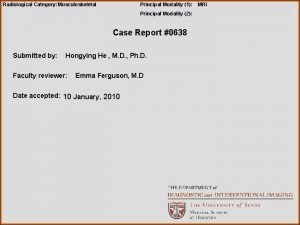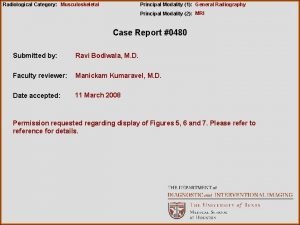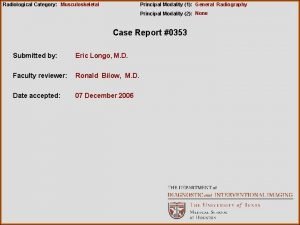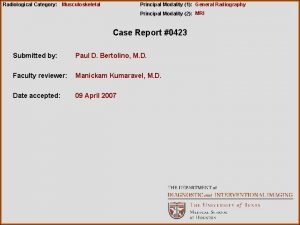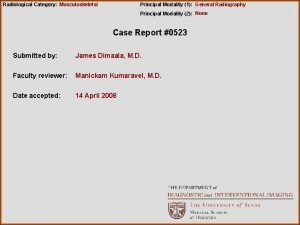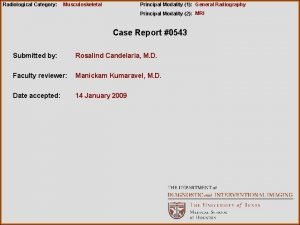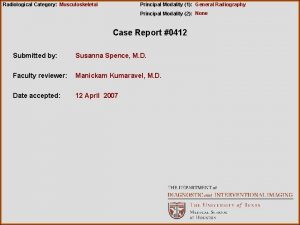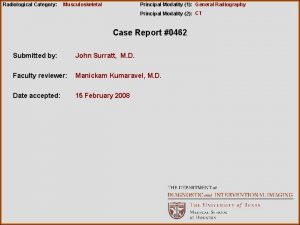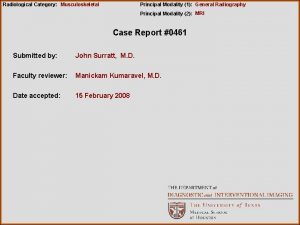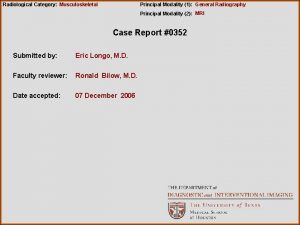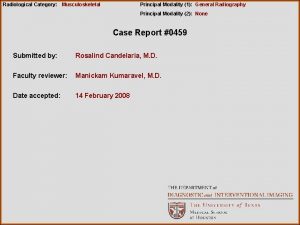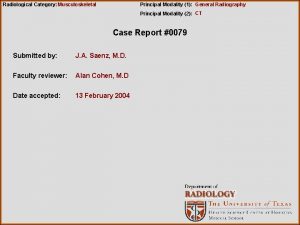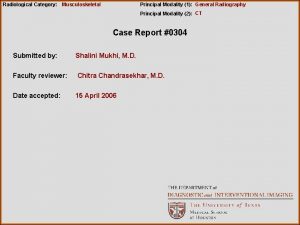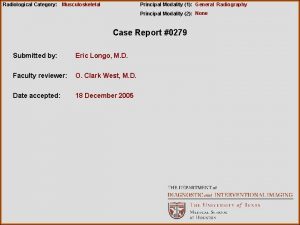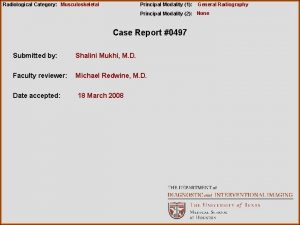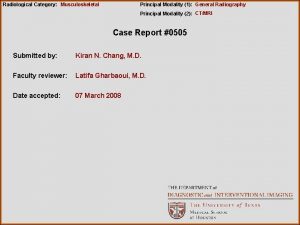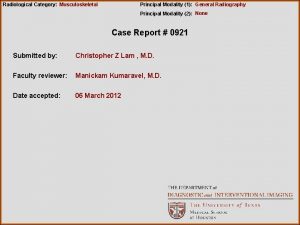Radiological Category Musculoskeletal Principal Modality 1 Radiography Principal



















- Slides: 19

Radiological Category: Musculoskeletal Principal Modality (1): Radiography Principal Modality (2): MRI Case Report # 756 Submitted by: Joshua Franklin, M. D. Faculty reviewer: Ronald Bilow, M. D, The University of Texas Medical School at Houston Date accepted: 7 February, 2011

Case History 15 year old male presents with a 1 year history of intermittent left knee pain which has progressed to the point where he has given up many of his previous activities including football. He has no history of trauma and there is no obvious mass or swelling on physical exam.

Radiological Presentations Figure 1: AP and lateral radiographs of the right knee

Radiological Presentations Figure 2: Magnification of the lateral view shown in figure 1

Radiological Presentations Figure 3: Sagittal and coronal T 1 weighted images

Radiological Presentations Figure 4: Axial T 1 precontrast and Axial T 1 fat sat post contrast images

Radiological Presentations Figure 5: Axial and Sagittal T 2 weighted images with fat saturation

Test Your Diagnosis Which one of the following is your choice for the appropriate diagnosis? After your selection, go to next page. • Osteomyelitis • Cortical Desmoid • Fibrous Dysplasia • Osteosarcoma • Benign Fibrous Cortical Defect

Findings At the posterior aspect of the distal left femoral metaphysis, there is an area of cortical thickening and irregularity extending approximately 2 cm craniocaudally (straight arrow). The abnormality is near the origin of the gastrocnemius muscle (curved arrow). No soft tissue abnormality or joint effusion is present. No definite abnormality was identified on the accompanying AP radiograph.

Findings Sagittal T 1 weighted image demonstrates a well defined, cortically based lesion with intermediate T 1 signal at the posteromedial aspect of the distal femur at the origin of the medial head of the gastrocnemius muscle. A T 1 hypointense border is consistent with sclerosis and there is no adjacent marrow signal abnormality.

Findings T 1 pre-contrast and T 1 post contrast images with fat saturation show that the lesion is confined to the cortex and enhances. There is no soft tissue or intramedullary component.

Findings Sagittal and axial T 2 fat sat images demonstrate a cortical T 2 hyperintense lesion at the origin of the medial head of the gastrocnemius (arrows). Again, no soft tissue component or adjacent bone marrow signal abnormality is identified.

Differentials: • Cortical Desmoid • Benign Fibrous Cortical Defect • Osteosarcoma • Osteomyelitis

Discussion This is a classic case of a cortical desmoid, also known by the terms avulsive cortical irregularity and distal femoral proliferative cortical irregularity. Cortical desmoids are benign and self limiting lesions, that usually resolve spontaneously by the age of 20. Most are asymptomatic, but some may present with local pain and swelling. Awareness of these lesions is important so as not to confuse them with more aggressive entities. If characteristic findings are present, the diagnosis of a cortical desmoid can be made confidently with imaging alone. 1 -3 Cortical desmoids are fibrous lesions most commonly found at the posteromedial aspect of the distal femur in 10 -15 year old males. They are formed by proliferation of periosteal fibroblasts at the insertion of the adductor magnus or the origin of the medial head of the gastrocnemius muscle secondary to chronic traction related stress. There may also be a history of abnormally strenuous physical activity. 1 -3

Discussion On plain radiography, a coritcal desmoid will present as a cortical irregularity or erosion with a sclerotic base typically at the posteromedial distal femur. Periosteal reaction may also be seen. The poorly defined appearance can cause confusion and suggest a more aggressive lesion; however, if these classic findings are present in the setting of a benign clinical course, radiography alone is diagnostic. 1, 3 Despite the diagnostic ability of radiographs, cross sectional imaging, particularly MRI is frequently pursued. On MRI, a well defined, cortically based, enhancing lesion with high T 2 and low to intermediate T 1 signal will be found in the posteromedial distal femur. A hypointense rim on both T 1 and T 2 weighted images represents the sclerosis also seen on radiographs. MRI also clearly demonstrates the location of the lesion at tendon attachment sites. Pertinent negatives are the absence of both a soft tissue mass and medullary involvment. 1, 2

Discussion Cortical desmoids are somewhat similar to benign fibrous cortical defects. Both are fibrous cortical lesions found in the metaphyses of children and adolescents, which tend to resolve spontaneously by adulthood. Both demonstrate sclerotic margins without an associated soft tissue mass or medullary involvement. Benign fibrous cortical defects, however are more well defined on radiographs and do not demonstrate periosteal reaction unless associated with a pathologic fracture. Also, although commonly found at the knee, benign fibrous cortical defects are not confined to areas of tendinous attachment. 3, 4 Early osteomyelitis can also present as a focal cortical irregularity and periosteal reaction. Invariably, there will also be soft tissue swelling and bone marrow edema in association with osteomyelitis, which allows for simple differentiation from a cortical desmoid. 1, 4

Discussion The most important job for the radiologist when presented with a case of cortical desmoid is to recognize the lesion as benign so as to avoid further workup and biopsy. Many malignancies including osteosarcoma can present as a cortical irregularity. Malignancies, however, will usually present with either a soft tissue mass, medullary involvement, or more permeative cortical destruction not seen with the benign cortical desmoid. 1 Despite its irregular appearance, the diagnosis of a cortical desmoid should not be difficult to make. An irregular cortical lesion at the posteromedial femur of an adolescent male near the origin of the medial head of the gastrocnemius without medullary involvment or a soft tissue mass are the diagnostic findings. Follow-up radiographs can be obtained to confirm stability or regression, but biopsy should be avoided and MRI is usually not necessary.

Diagnosis The classic location, radiographic appearance, and clinical presentation clinch the diagnosis of a cortical desmoid. No further workup is necessary.

References 1. Gould CF, Ly JQ, Lattin Jr GE, Beall DP, Sutcliffe III JB. Bone Tumor Mimics: Avoiding Misdiagnosis. Current Problems in Diagnostic Radiology. 2007; 36: 124 -41. 2. Stacy GS. Contour irregularities of the distal femur caused by developmental, traumatic, and benign cortically-based neoplastic conditions: radiographic and MRI correlation. Clinical Radiology 2004; 59: 793– 802. 3. Kumar R, Madewell JE, Lindell MM, Swischuk LE. Fibrous Lesions of Bones. Radiographics. 1990; 10: 237 -256. 4. Manaster BJ, May DA, Disler DG. Musculoskeletal Imaging: The Requisites. 3 rd Edition. Philadelphia, PA: Mosby, 2007; 467 -470, 545 -550.
 Erate category 2 eligible equipment
Erate category 2 eligible equipment Tennessee division of radiological health
Tennessee division of radiological health Center for devices and radiological health
Center for devices and radiological health National radiological emergency preparedness conference
National radiological emergency preparedness conference Radiological dispersal device
Radiological dispersal device Modality in software engineering
Modality in software engineering Cardinality and modality in database
Cardinality and modality in database Modality
Modality High modality examples
High modality examples Pacs modality workstation
Pacs modality workstation Capacitive field diathermy
Capacitive field diathermy Sensory vs somatic
Sensory vs somatic Sodality vs modality
Sodality vs modality Deontic modality
Deontic modality Crow's foot notation
Crow's foot notation Cardinality and modality
Cardinality and modality Modality erd
Modality erd Tom arbuthnot
Tom arbuthnot Epistemic modality
Epistemic modality Birads grading
Birads grading




















